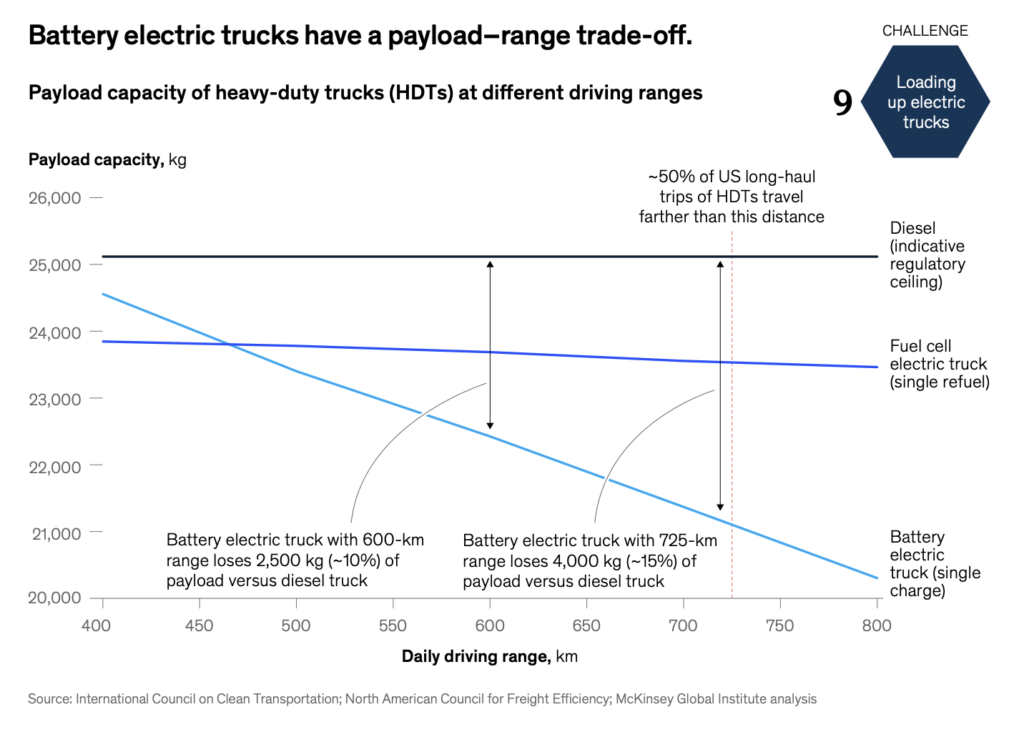The energy transition is a physical transformation in its early stages. Optimized over centuries, today’s energy system has many advantages; however, the production and consumption of energy account for more than 85 percent of global carbon dioxide (CO2) emissions. What challenges lie ahead? McKinsey presents an in-depth analysis of challenges. McKinsey looks at mobility, buildings, and industry.
Battery electric trucks
Battery electric trucks (BETs) and hydrogen-powered fuel cell electric trucks (FCETs) are gaining attention as alternatives to internal combustion engine (ICE) vehicles in the medium- and heavy-duty trucking sector, particularly as global efforts to reduce transportation emissions intensify. However, both technologies face significant physical and infrastructural challenges that must be addressed before they can be widely adopted—especially in use cases requiring long-range travel without the need to stop for recharging or refueling.
BETs face a core challenge in striking a balance between payload and range. Increasing a truck’s range requires adding more battery capacity, which adds weight and reduces the allowable payload due to strict vehicle weight regulations. For instance, to achieve a 600-kilometer range, a BET may sacrifice up to 2,500 kg—or about 10%—of its payload capacity compared to a diesel truck. For a 725-kilometer range, that loss could increase to 4,000 kg, or 15%. Given that over half of regional and long-haul freight in the U.S. exceeds these distances, these trade-offs pose severe constraints.
Market adoption of electric trucks is limited, particularly for high-payload, long-distance transport. McKinsey’s Achieved Commitments scenario predicts the stock of electric trucks would need to grow by over 100 times by 2050 to meet decarbonization goals. Although China leads the market—accounting for nearly 90% of global medium- and heavy-duty electric truck sales in 2022—other regions are only beginning to scale up.
Hydrogen trucks
Fuel cell electric trucks offer an alternative, as hydrogen fuel has a higher energy density than batteries and could theoretically allow for heavier payloads. However, the placement and weight of hydrogen tanks can lead to axle load imbalances, potentially breaching regulated limits. Additionally, the most critical barrier to FCET adoption is the lack of hydrogen refueling infrastructure and a mature hydrogen supply chain—challenges that are deeply interconnected with broader energy system transformations.

Solutions for e-trucks
Given these challenges, a multi-pronged approach is necessary. Key solutions being explored include:
- Improving battery energy density: Technological progress in battery chemistry could allow BETs to carry heavier loads over longer distances. Some newer models claim 800-kilometer ranges, though only a few have been deployed as of 2024.
- Adjusting regulatory weight limits: Increasing legal weight thresholds for zero-emission trucks, as proposed in the EU, could offset battery weight penalties; however, such changes raise concerns about safety and infrastructure.
- Optimizing routes and charging schedules: Reconfiguring logistics—for example, by scheduling recharging during mandatory breaks, such as the EU’s 4.5-hour driving limit—could enable Battery Electric Trucks (BETs) to match the performance of Internal Combustion Engine (ICE) trucks. However, this requires reliable access to high-power charging stations along routes and may be impractical for routes with unpredictable scheduling.
- Developing hydrogen infrastructure: The growth of FCETs depends on investment in hydrogen production and refueling. Modular, decentralized refueling stations are being explored to enable more flexible deployment.
Regional differences also play a significant role. For example, EU countries such as Finland and Denmark have vastly different legal weight limits and freight profiles, which impact the feasibility of electric trucks. Simulations suggest that 20% to 45% of long-haul trucking use cases in Europe and the U.S. may not be serviceable by battery electric trucks (BETs) on a single charge with current battery technology.
Innovation
Ultimately, the widespread decarbonization of trucking will require technological innovation, tailored deployment strategies, and reforms to logistics and regulations. Both BETs and FCETs will likely need to be applied to specific use cases where they are most effective. For instance, BETs may be better suited for urban or regional routes with established charging infrastructure, while FCETs may serve long-haul applications where range and refueling speed are critical.
Success will also depend on coordination across multiple sectors, including energy, transportation, and policy, underscoring the complexity and interdependency of transitioning heavy-duty trucking to zero-emission technologies.
Source: McKinsey
